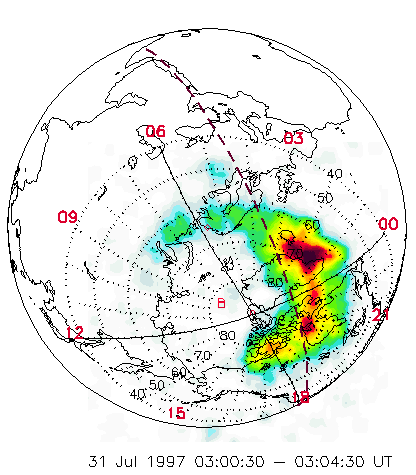Home
| Contact Info
| Bio
| Research
| Collaboration
| Publications
Thesis for Doctor Scientiarum (Ph.D)
University of Bergen, December 1999

My thesis for the Dr. Scient. degree was devoted to the study of
X-ray data from the PIXIE (Polar Ionospheric X-ray Imaging Experiment) camera
on board the POLAR satellite. This camera has provided the first
true two dimensional pictures of the global X-ray aurora. The focus of the thesis has
been to evaluate the remote sensing technique of X rays and especially to extract
spectral information about the parent electron precipitation
The monograph and the papers that constitutes the thesis are all available as pdf documents (below)
The Thesis
Published papers in the thesis
- Paper 1. Simultaneous Measurements of
X-rays and Electrons During a Pulsating Aurora Ann. Geophysicae, 16, 148 - 160, 1998
- Paper 2. Global Scale Electron
Precipitation Features seen in UV and X-rays During Substorms ,
J. Geophys. Res. , 104, 10,191 - 10,204, 1999.
Fourteen substorms are examined in PIXIE and UVI onboard Polar. LANL, WIND and groundbased data
are examined for each event. The different phases of the substorm are studied.
The time development in every two hour
local time sector are shown and we focus on the intensified precipitation seen in the
morning sector delayed relative to onset, which is seen in all the fourteen substorm events. Drift
time calculations show that the intensification is most probably caused by the electrons
injected in the midnight sector, drifting into the morning sector where some mechanism
scatter the electrons into the loss cone.
- Paper 3. Magnetospheric and Ionospheric Response to a Substorm: GEOTAIL HEP-LD
and POLAR PIXIE Observations, J. Geophys. Res. Vol. 104, No. A12, p. 28,459. 1999.
Two substorm onsets are observed 10 December 1996
by GEOTAIL (in the far midnight tail region), as
reconnection and ion flow events and by PIXIE as X-ray emissions from the ionosphere.
Additional data from WIND,LANL and ground based magnetic measurements are
studied. Using the Tsyganenko model of 1996, the contours of
X-ray emissions are mapped into the equtorial plane,
indicating the localion of the source region for the
precipitation. The dataset is interpreted and a possible
scenario for the two substorm onsets are presented.
- Paper 4. Global X-ray emission during an
isolated substorm - A case study ,
Special issue of J. Atmos. Solar-Terr. Phys., Vol. 62 (10), p. 889 - 900, 2000.
An isolated substorm uccurring September 4, 1997 is studied. PIXIE and UVI images, Geotail particle measurements
in the tail and NOAA-12 and DMSP low altitude satellite data are used to study the substorm.
Measured and calculated X-ray profiles in the morning sector are presented
- Paper 5. Localized maximum of X-ray
emission in the morning sector caused by drifting electrons
,J. Geophys. Res., Vol. 105, No A9, p. 20,869 - 20,885, 2000
Technical Report in the thesis
Unrefereed Papers, Posters and Talks, i.e., prestudies for the papers listed above
- Global Scale Electron
Precipitation Features During Substorms,Poster at the AGU
fall meeting 1997 (awarded as an Outstanding Student Paper)
- Global Scale Electron
Precipitation During Substorm Expansions, Proceedings of
the International Conference on Substorms -4, 1998, Terra Scientific
Publishing Company, Tokyo, Y.Kamide, editor
- Magnetospheric and Ionospheric Response to a Substorm: GEOTAIL HEP-LD
and POLAR PIXIE Observations,
Poster at the AGU
spring meeting 1998
- Intensified Energetic Electron Precipitation in the
Morning Sector Caused by Drift ing Electrons,
Invited talk at the Sixth Huntsville Modeling Workshop, Guntersville,
Alabama, 26-30 October 1998
- Localized maximum of X-ray
emission in the morning sector caused by drifting electrons,
Talk at AGU spring meeting, June 1-4,1999, Boston
Back to: Home
or Top of this page
or Bio
or Publications
Last Updated: August 2004
by Nikolai Østgaard
http://folk.uib.no/nfyno/Phd.html
